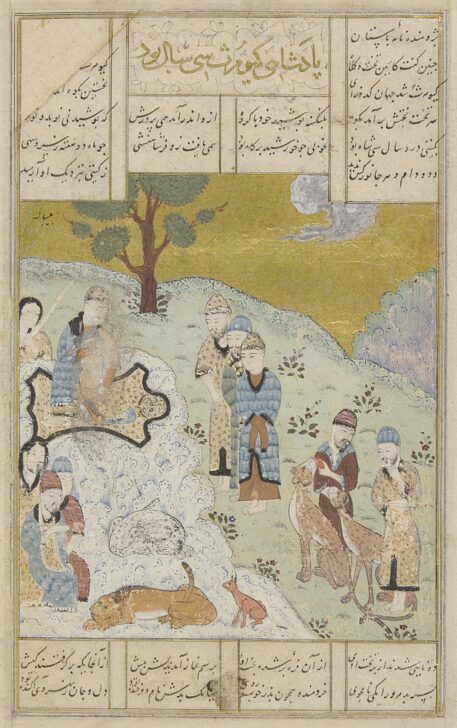Gaiumart the First Shah, from the Shahnama of Firdausi
Iranian

Description
The first illustration in many editions of the Shahnama often related to Gaiumart, the legendary founder of the Iranian royal dynasty, who brought civilization to a wild land and people:
He who compiled the ancient legendary,
And tales of paladins, saith Gaiumart
Invented crown and throne, and was a Shah. . . .
Its lord was Gaiumart, who dwelt at first
Upon a mountain; thence his throne and fortune
Rose. He and all his troop wore leopard-skins,
And under him the arts of life began,
For food and dress were in their infancy.
He reigned o’er all the earth for thirty years,
In goodness like a sun upon the throne,
And as a full moon o’er a lofty cypress
So shone he from the seat of king of kings.
The cattle and the divers beasts of prey
Grew tame before him; men stood not erect
Before his throne but bent, as though in prayer.
Warner, I, 118–19
These verses contain metaphors that re-occur throughout the Shahnama as emblems of heroes or righteous kings—such as a tall cypress tree and the light of both the sun and the moon—and the artist has given them due emphasis in his pictorial translation. The cypress towers over the figure of the shah like a canopy, while the moon emerges from a cloud, and the sun is suggested by the golden sky. Gaiumart’s mountain origins are evoked by a stylized mass of pale blue rocks, which serve as a kind of natural throne. At some point in the manuscript’s history, sadly, the figure of Gaiumart was deliberately effaced.
———
Maribeth Graybill, Senior Curator of Asian Art
Exhibited in "A Medieval Masterpiece from Baghdad: the Ann Arbor Shahnama"
August 14 through December 19, 2004
Subject Matter:
Gaiumart The First Shah
He who compiled the ancient legendary,
And tales of paladins, saith Gaiumart
Invented crown and thrown, and was a Shah.
This order, Grace, and lustre came to earth
When Sol was dominant in Aries
And shone so brightly that the world grew younh.
Its lord was Gaiumart, who dwelt at first
Upon a mountain; thence his throne and fortune Rose.
He and all his troop wore leopard-skins,
And under him the arts of life began,
For food and dress were in their infancy.
He reigned o'er all the earth for thirty years,
In goodness like a sun upon the throne,
And as a full moon o'er a lofty cypress
So shone he from the seat of king of kings.
These verses contain metaphors that re-occur throughout the Shahnama as emblems of heroes or righteous kings—such as a tall cypress tree and the light of both the sun and the moon—and the artist has given them due emphasis in his pictorial translation. The cypress towers over the figure of the shah like a canopy, while the moon emerges from a cloud, and the sun is suggested by the golden sky. Gaiumart’s mountain origins are evoked by a stylized mass of pale blue rocks, which serve as a kind of natural throne. At some point in the manuscript’s history, sadly, the figure of Gaiumart was deliberately effaced.
Physical Description:
This painted miniature Shahnama page was made by the Shiraz and Timurid schools, ca. 1460 in Baghdad, Iraq. The painting is done in ink, opaque watercolor and gold leaf on paper. The scene depicts Gaiumart the First Shah from the Shahnama, the Persian book of kings.
Usage Rights:
If you are interested in using an image for a publication, please visit https://umma.umich.edu/request-image/ for more information and to fill out the online Image Rights and Reproductions Request Form.